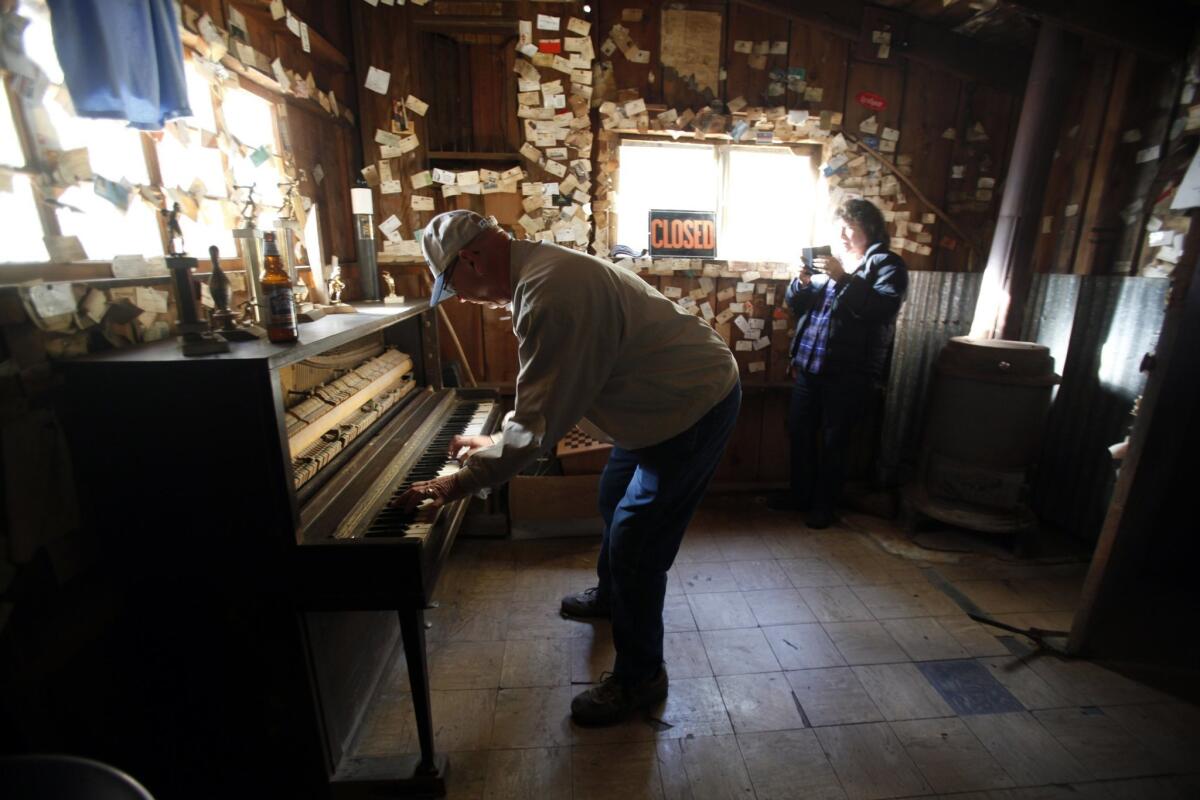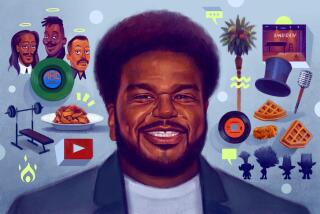Setting Times stories to music: From Donna Summer to the Verve

Every day, the stories I edit bring songs to mind. But this week, two of the stories also brought films to mind.
When I started reading Monday’s Great Read about two young men’s project to map every swimming pool in the L.A. Basin, I immediately pictured Burt Lancaster swimming his way through a string of backyard pools in the unnerving 1968 movie “The Swimmer.”
Lancaster, one of the bravest actors of his generation, is haunting as a bluff suburbanite with a megawatt grin who goes on a journey of self-discovery – ending at a home that is no longer his.
But the film-story connection was even stronger with Wednesday’s Great Read, about an abandoned mining town for sale in California’s gold country. And even better—it was one of my favorite films, “McCabe and Mrs. Miller.” If I could have found a way to watch the movie while editing, I would have.
If you haven’t seen the film (and you must), it stars Warren Beatty, looking about as un-Beatty as possible, as a loser-dreamer in a beyond-bleak mining town. I love his mumbled soliloquies. At one point he sits on his bed and frets about why the Julie Christie character doesn’t love him. Half-defensively, half-doubting, he says, “I’ve got poetry in me.”
If any line will stay with me until the end of my time, it’ll be that one.
The sepia look of the movie adds to its moodiness. It’s like Robert Altman filmed the movie using some kind of snow filter, even for the interior scenes. And you know what makes it even better? The Leonard Cohen songs that serve as a soundtrack. Now that I could listen to while editing.
Anyway, in these roundups of the week gone by, I’d like to offer the first paragraphs of each Great Read (or, as they’re known in print, Column One) -- maybe they’ll buy your eye and you can settle in for a good weekend read. And you’ll also get the songs that inspired me while editing the stories, or reading them later if my fellow editor Millie Quan ushered them through. A story-song combo!
#
Mappers spot all the pools in L.A. Basin
German graphic designer Benedikt Gross was flying into Los Angeles for the first time when he gazed out the jetliner’s window and was mesmerized by the hundreds of shimmering blue swimming pools tiling the landscape below.
The image of all those backyard oases visible only from the sky stuck with him, but he didn’t make much of it until a few months later, when he bumped into Joseph Lee at a Massachusetts Institute of Technology research lab that deals with urban dwellers’ relationship with technology.
“I wonder how many pools there are,” said Gross, 33, who was working at the Senseable City Lab as part of his master’s degree studies at London’s Royal College of Art.
Lee, a UCLA graduate who was at MIT as a research assistant, responded quickly: “L.A. is endless from the air. The turquoise pools you see are beautiful.”
But they knew the number of pools was finite, and on a whim they decided to find out exactly how many there were.
“We didn’t know where we were going,” remembers Lee, 23, an aspiring geographer and cartographer from Vallejo. “Things just built themselves the more we dove deeper.”
A year later, the result is the “Big Atlas of L.A. Pools,” a digital analysis of every swimming pool in the Los Angeles Basin. Using complex computer mapping, they counted 43,123 between the Hollywood Hills and San Pedro, from pools shaded by leaf-covered pergolas in Santa Monica to ones surrounded by chain-link fences in Alhambra.
Along the way, they discovered something more than just the real-world versions of the iconic David Hockney pool utopias. Their project also proved that two non-experts were able to take a massive amount of freely available data to peek into other people’s lives.
“At first, the project was mostly just an experiment to see whether or not we could locate and draw all the pools from aerial imagery we acquired,” Lee says.
But they became unnerved by the easy access to the data, he says.
“It’s creepy to know that encoded in the freely available information are very personal details that you may not want others to know.”
#storysongs combo: “Swimming Pools and Movie Stars,” by the Wedding Present. (And on another musical note, don’t you love how one of the photos accompanying the story online looks like the cover for Nirvana’s “Nevermind”?
#
Pair sheds new light on L.A.’s claim to neon fame
The brightly illuminated billboard was a traffic-stopping sensation in 1923 Los Angeles, a city just starting its love affair with automobiles. Sitting atop a downtown hotel, the sign was rimmed in glowing blue and spelled out “Packard” in radiant red letters at least 4 feet high.
People drove long distances to view this newfangled technology called neon at the corner of 7th and Flower streets. They called it “liquid fire.” Congestion got so bad that the police were called in.
That’s the popular recounting of how neon made its debut in America: With his Packard sign, Los Angeles businessman Earle C. Anthony was the first to use those candy-colored glass tubes, beating out everyone else in the country — including New York. For decades, the story has been widely accepted in neon circles as fact.
But is it true?
Academic Dydia DeLyser didn’t set out to debunk anything when she decided to research the history of neon.
But that simple scholastic decision ended up launching a yearlong search that took DeLyser and her research and life partner, Paul Greenstein, into the bowels of Los Angeles institutions to track down newspaper articles, permits and building records.
It ended in a windowless room at UCLA where file cabinets held thousands of 8-by-10 glossies showing Los Angeles from the sky — and one “aha!” photograph.
#storysongs combo: “Neon Wilderness,” by the Verve. Far from my favorite song on the brilliant “Urban Hymns,” but still lovely.
#
Craigslist ad makes gold country ghost town a hot property
The road to this abandoned gold mining town is six miles long, mostly dirt and gravel, snaking along a ridge hundreds of feet above the north fork of the Feather River.
Bill Davies takes the turns slowly in his pickup; a wrong twist of the wheel has sent less careful drivers sliding off the road. There’s no snow or rain, but even clear days require cautious preparation, and Davies has brought a chain saw just in case strong winds have toppled any pines or cedars onto his path.
His dog, a mutt named Tom Tom he found abandoned, runs alongside as his truck passes patches of trees charred in last year’s forest fire. Up ahead, a sign warning of rock slides is pocked with bullet holes.
“Drunk hunters, probably,” Davies says.
The road ends in a clearing, where a plaque declares that “gold was found in 1851 and a wild mining town was born,” with a nearby post office, hotel, blacksmith and a steady supply of gold-hungry miners.
These days, it’s home to three dilapidated cabins, some sheds, a few old motor homes and a weathered bar called the Gin Mill, where for nearly six decades a tiny woman named Marie Sabin served up ice-cold beers chilled in a propane-powered refrigerator.
Outside the bar’s front door, the wall is blanketed with business cards tacked up by visitors from as far away as Long Beach. A sign in the window says the bar is open, but there’s no one around.
Davies, who grew up nearby in Northern California’s mining country, loves the Gin Mill as much as any nondrinking man could possibly love a bar.
“It is sad the bar is not open,” he says. “It’s real sad.”
Now the bar and the surrounding 10 acres are for sale. A catchy Craigslist ad for the property has ricocheted across the Internet, piquing the interest of locals and “flatlanders” far from the Plumas National Forest. Inquiries have poured in from around the state, the country and as far away as Europe.
#storysongs combo: “Mining for Gold,” by the Cowboy Junkies. I absolutely loved the archival footage of (coal, not gold) miners from Michigan in the video. Gave me chills.
#
Tiny museum in New York showcases the ordinary
New York’s smallest museum has reached its capacity of three, and Nicholas Kokkinis, volunteer docent, feels obliged to amuse the waiting crowd.
He points to the museum cafe (a cappuccino machine mounted on the wall) and gift shop (postcards and pencils above the cafe), both tucked inside a 60-square-foot refurbished elevator shaft in a trash-strewn alley in Chinatown.
“In case you want to read a little bit more about our exhibit on fake vomit or our exhibition on potato chips bags from around the world, you can call the numbers on your exhibit on the phone,” he says to the Japanese tourists, Brooklyn hipsters and young couples.
One visitor uses his iPhone to dial in and hear about the exhibit that lines the left wall of the museum, which includes the gold laminated sneakers of onetime porn magnate Al Goldstein. Chelsea Kasen, 24, steps back and takes a picture, making sure to include the graffiti-covered wall outside the museum.
“It’s finding beauty in the unexpected,” she said about the tiny space. “It looks like an abandoned alley, but in it is something you can learn from, which adds value to something that seems meaningless.” (She was headed next to a club where stand-up comedians tell jokes to porcelain dolls.)
Part of New York’s appeal is the eccentric things that pedestrians encounter: unicycling dog walkers, vegan drum circles, startling vistas of skyscrapers. Now there’s this place, called simply Museum, which could fit in a closet at the Metropolitan Museum of Art and is accessible 24 hours a day.
#storysongs combo: “A Time to Be So Small,” by Interpol.
#
A healthcare navigator in unfriendly waters
Snow came early to the cotton and sorghum fields here, sending dozens of cash-strapped families to the food bank on a recent afternoon for frozen chickens, cucumbers and canned green beans.
Quinetta Rascoe was waiting for them.
Wearing a bright pink overcoat, a glittery rainbow scarf and an infectious grin, Rascoe climbed out of a Toyota sedan carrying a stack of Obamacare brochures.
She eyed about 60 cars that were snaking into the parking lot behind Murfreesboro Baptist Church, prompting an unusual traffic jam one block off the town’s dozy Main Street.
The food truck was late, and white plumes floated up from mufflers as the drivers switched their engines on and off and on again to warm themselves with blasts of heat.
“OK,” Rascoe said, grabbing a pile of freshly printed business cards. “Let’s go talk to people.”
Rascoe is one of thousands of foot soldiers hired nationwide to sign Americans up for coverage under President Obama’s Affordable Care Act.
Her task is made all the more challenging because she works in one of the Republican-led states openly hostile to the act. The GOP-controlled Legislature ordered state health officials not to cooperate with the federal program.
Many of the people in this rural swath of North Carolina — despite being among the neediest potential beneficiaries of Obamacare — remain skeptical and uninformed.
Walking up to the first vehicle, Rascoe smiled, shuffled on the balls of her feet and wiggled her fingers to get the perplexed driver of a dinged blue pickup to roll down the window. She explained she was there to answer questions about the Affordable Care Act.
The man mumbled a greeting, took the flier and quickly rolled up the window.
“Next car!” Rascoe said.
She felt lucky if she could persuade a driver to crack open the car window to take her card and a brochure. Some ignored her, a few listened politely.
“I just smile and give them the information; sometimes a light bulb goes off later and they call,” Rascoe said.
#storysongs combo: “She Works Hard for the Money,” by Donna Summer. “So you better treat her right...”
#
If you have ideas for story-song pairings of your own, tweet the title and artist to @karihow or @LATgreatreads with the hashtag #storysongs.
More to Read
Start your day right
Sign up for Essential California for news, features and recommendations from the L.A. Times and beyond in your inbox six days a week.
You may occasionally receive promotional content from the Los Angeles Times.





